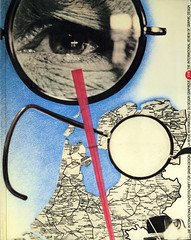Tuesday, 6:23pm
2 January 1990
Images and information
Envisioning Information
Edward Tufte Graphics Press, £30Seven years have passed since Edward Tufte wrote The Visual Display of Quantitative Information published by his own company, Graphics Press. Not a catchy title, but a compelling book, hailed by the press – scientific journals and newspapers alike – for shedding light where confusion too often reigns. The Boston Globe called it ‘a visual Strunk and White’, doing for graphical data what those authors’ The Elements of Style has long done for the written word.
Envisioning Information gives Tufte a broader canvas – though certainly no less fine a brush – on which to consider the graphical display of information of all kinds. And an added reason for interest in Tufte’s thinking arises from the fact that in the years between the two books he has been appointed as a consultant on electronic interface graphics to IBM, occupying a role analogous to that performed by Richard Sapper for IBM’s products. It will be partly Tufte’s doing if IBM manages to catch its upstart rival, Apple Computer, in matters of menu design in the near future.
Meanwhile, it is possible to delight in the printed mastery of Envisioning Information and to revel in the sheer ingenuity of two-dimensional renderings of four-dimensional (time and space) happenings, from the occurrence of sunspots to train times in Java, from instruction in dance steps to the presentation of criminal evidence.
There is a serious point behind the entertaining examples. Even the apparently rudimentary graphs in The Economist, for example, pack a huge amount of information. When the eye lights upon some of Tufte’s examples it seems almost a wonder we choose to communicate our ideas in words at all. Yet, as he observes, the design of information has received little critical attention. He beings to make up for that by attacking the trite decorated graphs popular in colour magazines such as Time and Business Week. This ‘chartjunk’ commits the cardinal sin of adding decoration without adding information.
These are the basics. More subtle are designs that may be read both as a whole and in detail, yielding different information. Tufte’s best examples of such ‘micro / macro readings’ are the Vietnam Veterans Memorial in Washington DC, where it is the contrast of scales that gives the monument its emotional impact, and the famous axonometric map of Manhattan by Constantine Anderson, which shows each building in intimate detail. Handled with such consummate skill, the detail clarifies, not confuses. It is far harder to get lost using this map than with a conventional schematic plan. Add detail, not clutter, is Tufte’s advice.
Envisioning Information really finds its purpose when it comes to colour. It is no co-incidence that the finest maps tend to be those with the least colour, yet the lesson learned long ago by cartographers has still not been heeded by those responsible for computer and television graphics. Here, Tufte takes his cue from the cartographer Eduard Imhof and from artist Paul Klee. However, the results are slightly disappointing, as is the romantic advice to use colours found in nature. This does not narrow the choice very much (one could assemble a hideous computer display from the colours in Van Gogh’s oils or, for that matter, from those in the subjects he painted), but according to Tufte, ‘Nature’s colours are familiar and coherent, possessing a widely accepted harmony to the human eye.’ Good maps do use colours from nature, but Tufte has not told the full story of their selection and juxtaposition.
Serious clarity is not always the best policy, even in Tufte’s book. A small collection of designs that exceed their bounds provide a welcome relief. A chart of American rivers, for example, was not scaled so the longest could be laid out straight along the page – that would make many f the others almost imperceptibly small. Instead, the Mississippi and the Amazon wrap around the page, taking the corner and doubling back on themselves. And in 1928, Brazilian animal product exports soared to such a level that they no longer fit on the bar chart alongside previous years’ results. No problem: the 1928 bar simply bends back in the space over the 1927 bar. There is inspiration to be found in many of the illustrations, both serious and flippant.
It is an elegance of Tufte’s own design that his book looks as if it presents a continuous text. In fact, much is in the form of extended captions to the graphical and pictorial examples. As a result, all the text pertinent to a particular image is shown alongside it. This is not uncommon in supposedly well-designed books, though often at the expense of either cutting or padding the text or awkwardly sizing the illustration. It is impossible to tell if either of these tricks has been employed here. Tufte’s page layout is both polished as a design and enjoyable to read: a welcome contribution to a subject of real importance.
First published in Eye no. 1 vol. 1, 1990.

Eye is the world’s most beautiful and collectable graphic design journal, published quarterly for professional designers, students and anyone interested in critical, informed writing about graphic design and visual culture. It is available from all good design bookshops and online at the Eye shop, where you can buy subscriptions, back issues and single copies of the latest issue.